Related Research Articles

Warren Wilbur Shaw was an American racing driver. The second three-time winner of the Indianapolis 500, he is also remembered for serving as president of the Indianapolis Motor Speedway from 1945 until his death in 1954.
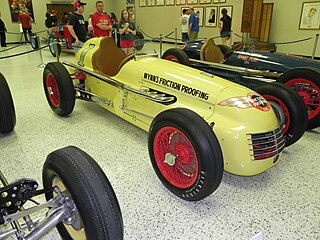
The 34th International 500-Mile Sweepstakes was held at the Indianapolis Motor Speedway on Tuesday, May 30, 1950. The event was sanctioned by the AAA and served as the premier event on the calendar of the 1950 AAA National Championship Trail.

The 35th International 500-Mile Sweepstakes was held at the Indianapolis Motor Speedway on Wednesday, May 30, 1951. The event was part of the 1951 AAA National Championship Trail, and was also race 2 of 8 in the 1951 World Championship of Drivers. For the second year in a row, no European Formula One-based teams entered the race.

The 36th International 500-Mile Sweepstakes was a motor race held at the Indianapolis Motor Speedway on Friday, May 30, 1952. It was the opening race of the 1952 AAA National Championship Trail and was also race 2 of 8 in the 1952 World Championship of Drivers.

The 37th International 500-Mile Sweepstakes was held at the Indianapolis Motor Speedway on Saturday, May 30, 1953. The event was part of the 1953 AAA National Championship, and was race 2 of 9 in the 1953 World Championship of Drivers. Bill Vukovich, after falling just short a year before, dominated the race, leading 195 of the 200 laps. Vukovich won the first of two consecutive "500" victories, finishing more than three minutes ahead of second place Art Cross.

The 38th International 500-Mile Sweepstakes was held at the Indianapolis Motor Speedway on Monday, May 31, 1954. The event was part of the 1954 AAA National Championship Trail, and was also race 2 of 9 in the 1954 World Championship of Drivers.

The 41st International 500-Mile Sweepstakes was held at the Indianapolis Motor Speedway on Thursday, May 30, 1957. The event was part of the 1957 USAC National Championship Trail and it was the third race of the eight-race 1957 World Championship of Drivers.

The 43rd International 500-Mile Sweepstakes was held at the Indianapolis Motor Speedway on Saturday, May 30, 1959. The event was part of the 1959 USAC National Championship Trail and was also race 2 of 9 in the 1959 World Championship of Drivers.

Donald C. Davidson was the historian of the Indianapolis Motor Speedway from 1998 to 2020, the only person to hold such a position on a full-time basis for any motorsports facility in the world. Davidson started his career as a statistician, publicist, and historian at USAC. His radio program, The Talk of Gasoline Alley, is broadcast annually throughout the "Month of May" on WFNI in Indianapolis, and he is part of the IMS Radio Network.

The Indianapolis Motor Speedway Radio Network, is an in-house radio syndication arrangement which broadcasts the Indianapolis 500, the NTT IndyCar Series, and Indy NXT to radio stations covering most of North America. The network, owned by the Indianapolis Motor Speedway and headquartered in Speedway, Indiana, claims to be one of the largest of its kind in the world. It currently boasts over 350 terrestrial radio affiliates, plus shortwave transmissions through American Forces Network and World Harvest Radio. The network is carried on satellite radio through SiriusXM, and is also accessible through online streaming, and downloadable podcasts. For 2017, the broadcast reached 20.5 million listeners.

The 29th International 500-Mile Sweepstakes Race was held at the Indianapolis Motor Speedway on Friday, May 30, 1941. The start of the race was delayed due to a fire that swept through the garage area on race morning. No persons were injured, but one car in the field was destroyed. The race rolled off with only 31 cars, and ran to its scheduled distance. This would be the final "500" prior to the United States involvement in WWII. It was not known at the time, but it would be the final race organized by Speedway president Eddie Rickenbacker, and due to the war, the race would not be held again until 1946.
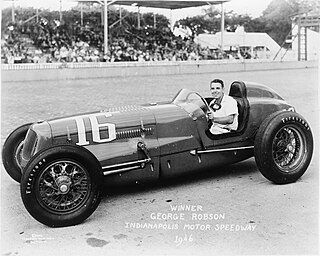
The 30th International 500-Mile Sweepstakes was held at the Indianapolis Motor Speedway on Thursday, May 30, 1946. This was the first Indianapolis 500 presided over by new track owner Tony Hulman. The track had closed in late 1941 due to World War II, and over the next four years, the facility fell into a terrible state of disrepair. Hulman purchased the Speedway in November 1945, and quickly went to work cleaning up the grounds, which had become overwhelmed by overgrowth and weeds. The Speedway re-opened, and the 1946 race was considered a rousing success.
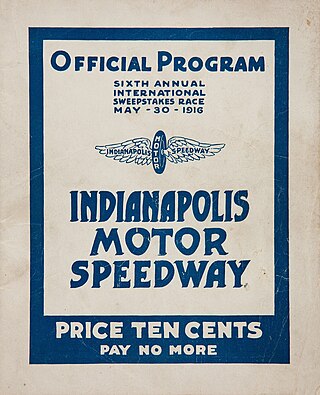
The 6th International 300-Mile Sweepstakes Race was the sixth running of the Indianapolis 500. It was held at the Indianapolis Motor Speedway on Tuesday, May 30, 1916. The management scheduled the race for 120 laps, 300 miles (480 km), the only Indianapolis 500 scheduled for less than 500 miles (800 km).

The 7th Liberty 500-Mile Sweepstakes was held at the Indianapolis Motor Speedway on Saturday, May 31, 1919.

The 18th International 500-Mile Sweepstakes Race was held at the Indianapolis Motor Speedway on Friday, May 30, 1930. The race was part of the 1930 AAA Championship Car season.
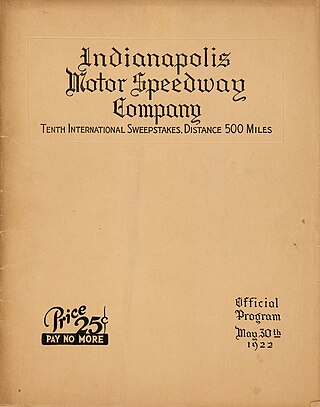
The 10th International 500-Mile Sweepstakes Race was held at the Indianapolis Motor Speedway on Tuesday, May 30, 1922.
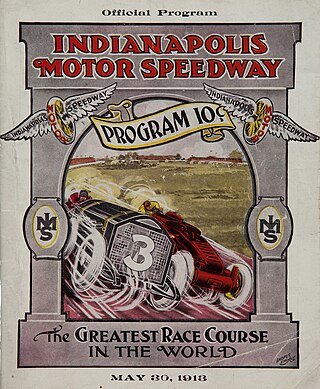
The Third International 500-Mile Sweepstakes Race was held at the Indianapolis Motor Speedway on Friday, May 30, 1913. Frenchman Jules Goux became the first foreign-born, and first European winner of the Indianapolis 500. His margin of victory of 13 minutes, 8 seconds over second place Spencer Wishart still stands, as of 2024, as the largest margin of victory in Indianapolis 500 history.
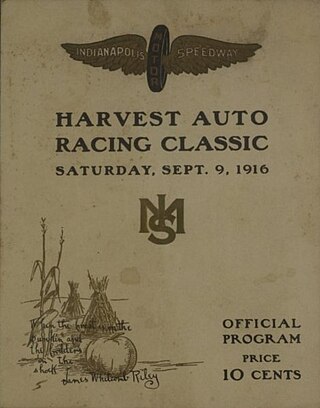
The Harvest Auto Racing Classic was a series of three automobile races held at the Indianapolis Motor Speedway on Saturday September 9, 1916. The meet, held four months after the 1916 Indianapolis 500, featured a 20-mile race, a 50-mile race, and a 100-mile race. The main event, a 100-mile Championship Car race, paid points towards the 1916 AAA National Championship. Johnny Aitken won all three races, two of which had a margin of victory of less than a car length.
Lou Palmer was an American broadcaster best known for his work at the Indianapolis 500 on the Indianapolis Motor Speedway Radio Network from 1958 until 1989.
References
- 1 2 "1942 Speedway Rules Unchanged". The Indianapolis Star. July 2, 1945. p. 18. Retrieved April 6, 2016– via Newspapers.com.

- 1 2 Bostwick, Mary E (February 3, 1946). "Old Speedway Office Lively Place Again; Orders Pour In". The Indianapolis Star. p. 3. Retrieved April 6, 2016– via Newspapers.com.

- ↑ "Famous Drivers Entertain Printers at Speedway". The Indianapolis Star. July 30, 1941. p. 16. Retrieved April 7, 2016– via Newspapers.com.

- ↑ "Officers Named By Veterinarians". The Indianapolis Star. August 15, 1941. p. 4. Retrieved April 7, 2016– via Newspapers.com.

- ↑ Patton, W. Blaine (August 27, 1941). "Moose Nominate Gray As Prelate". The Indianapolis Star. p. 1. Retrieved April 7, 2016– via Newspapers.com.

- ↑ "See Spirited Exhibitions at Speedway". The Indianapolis Star. August 28, 1941. p. 4. Retrieved April 7, 2016– via Newspapers.com.

- ↑ "P.O. Supervisors Will Hear Uttley". The Indianapolis Star. September 10, 1941. p. 5. Retrieved April 6, 2016– via Newspapers.com.

- ↑ "Order Tickets Now". The Indianapolis Star. December 15, 1945. p. 22. Retrieved April 6, 2016– via Newspapers.com.

- ↑ Patton, W. Blaine (December 23, 1941). "Union Asks Speedway Race Be Halted; Myers Says Plans Unchanged". The Indianapolis Star. p. 13. Retrieved April 6, 2016– via Newspapers.com.

- ↑ Patton, W. Blaine (December 12, 1945). "Paper, "Snipes" Litter Offices As Navy Ends Busy Recruiting Day". The Indianapolis Star. p. 25. Retrieved April 6, 2016– via Newspapers.com.

- ↑ "Speedway Race Plans Proceed". The Indianapolis Star. December 28, 1945. p. 6. Retrieved April 6, 2016– via Newspapers.com.

- ↑ "No Speedway Race". The Indianapolis Star. December 30, 1945. p. 2. Retrieved April 6, 2016– via Newspapers.com.

- 1 2 3 "500 Mile Race Is Off for Duration of War". The Milwaukee Journal. 1941-12-29. Archived from the original on January 24, 2013. Retrieved 2012-04-24.
- 1 2 Patton, W. Blaine (February 24, 1942). "If So - Why? In Sportland". The Indianapolis Star. p. 16. Retrieved December 22, 2017– via Newspapers.com.

- ↑ "All Auto Races Banned by ODT". The Indianapolis Star. July 4, 1942. p. 14. Retrieved December 22, 2017– via Newspapers.com.

- ↑ "Racing Deadline Changed by ODT". The Indianapolis Star. July 4, 1942. p. 18. Retrieved December 22, 2017– via Newspapers.com.

- 1 2 3 4 Oreovicz, John (2011-05-15). "Indy at 100: WWII puts racing on hold". Commentary. ESPN.com. Retrieved 2012-04-24.
- ↑ Rickenbacker 1967, p. 159.
- ↑ Cavin, Curt (May 27, 1995). "Speedway was at peace during war years (Part 1)". The Indianapolis Star. p. 61. Retrieved April 6, 2016– via Newspapers.com.

- ↑ Cavin, Curt (May 27, 1995). "Speedway was at peace during war years (Part 2)". The Indianapolis Star. p. 63. Retrieved April 6, 2016– via Newspapers.com.

- 1 2 Patton, W. Blaine (May 30, 1942). "If So - Why? In Sportland". The Indianapolis Star. p. 12. Retrieved November 8, 2018– via Newspapers.com.

- ↑ The Talk of Gasoline Alley. May 21, 2009. WFNI.
- ↑ The Talk of Gasoline Alley – WFNI, July 22, 2009
- ↑ The Legends of the Brickyard – 1985, ESPN
- ↑ The Talk of Gasoline Alley. May 23, 2014. WFNI.
- ↑ "The Most Famous Man in the World, 1940–1945". Bing Magazine. Retrieved May 28, 2014.
- ↑ "Speedway Links for Bing and Bob". The Spokane Daily Chronicle. Retrieved May 18, 2015.